The 8 most common types of Woodpeckers in Georgia
Ever dreamt of spotting species of woodpeckers in Georgia? You’ve come to the right place! In this blog, we’ll explore the many types of woodpeckers here, showcasing the diversity that makes Georgia a birdwatcher’s paradise. From the Pileated Woodpecker to the Northern Flicker – discover the variety of woodpecker species and the different types of woodpeckers that flourish in this region.
Plus, we’ll talk about conservation efforts and how you can help these majestic birds. These are considered the beautiful birds spotted in Georgia, the state of the United States, a true haven for bird enthusiasts across the United States.
Different Types of Woodpeckers in Georgia
1. Red-headed Woodpecker (Melanerpes erythrocephalus)

- Scientific Name: Melanerpes erythrocephalus
- Lifespan:
- Average: 9 years
- Maximum Recorded: 12 years
- Size: 7.5 to 9.1 inches (19 to 23 cm)
- Weight: 2 to 3.2 ounces (56 to 91 g)
- Wingspan: 14 to 17 inches (35 to 43 cm)
- Status: Least Concern
Explanation: The Red-headed Woodpecker, scientifically known as Melanerpes erythrocephalus, boasts an average lifespan of 9 years, with a maximum recorded lifespan of 12 years.
This bird typically measures between 7.5 to 9.1 inches in size, weighing in at 2 to 3.2 ounces. Its wingspan ranges from 14 to 17 inches. They have a distinctive black back with white wing patches that make them easily identifiable. The vibrant contrast of the white wing patches against their black feathers is a striking feature. As they soar through the sky, the white wing patches are often the first thing that catches the eye. These white wing patches not only play a role in flight dynamics but also add to the bird’s visual appeal. Birdwatchers often find the Red-headed Woodpecker’s white wing patches a captivating sight, contributing to its popularity among enthusiasts.
Remarkably, the species is classified as “Least Concern” in terms of conservation status.
Breeding typically occurs from April to July.
The Red-headed Woodpecker is a common sight in Georgia. They have a red head and black body, and can live in open woodlands, forests, and even urban areas.
These woodpeckers are known for unique feeding habits. They catch insects in mid-air or on the ground, and also eat fruits and nuts. Their favorite food also consists of small bird eggs.
Unfortunately, their population has decreased due to habitat loss and competition from European Starlings. Conservation efforts are underway to protect them and ensure their survival.
The Red-headed Woodpecker is a symbol of nature’s beauty and shows the importance of conservation, particularly in the face of habitat loss. Known for its diverse diet, the Red-headed Woodpecker thrives on its favorite foods found in its natural habitat. They are the perfect example of an animal that proves weightlifting and drumming can go hand in hand, highlighting the challenges these birds face as their natural environments continue to diminish. As they navigate these challenges, the availability of their favorite foods becomes crucial for their survival and well-being.
Nesting cavities: vital components in bird habitats, these natural or excavated hollows offer safe breeding and shelter sites for many species. Woodpeckers create nesting cavities that benefit secondary nesters like bluebirds and chickadees. The availability of nesting cavities significantly impacts bird population dynamics and biodiversity, underscoring their crucial role in sustaining avian communities.
Red-headed Woodpeckers Sound and Video
Red-headed Woodpecker (Melanerpes erythrocephalus) Range Map

2. Red-bellied Woodpecker (Melanerpes carolinus)

- Scientific Name: Melanerpes carolinus
- Lifespan:
- Average: 9 years
- Maximum Recorded: 12 years
- Size: 9 to 10.6 inches (23 to 27 cm)
- Weight: 2 to 3.2 ounces (56 to 91 g)
- Wingspan: 13 to 16.5 inches (33 to 42 cm)
- Status: Least Concern
Explanation: The Red-bellied Woodpecker, identified by its scientific name Melanerpes carolinus, shares a similar average and maximum recorded lifespan of 9 and 12 years, respectively from other bird species.
This species exhibits a size range of 9 to 10.6 inches and a weight of 2 to 3.2 ounces. The white wings with wingspan falls between 13 to 16.5 inches.
Like its counterpart, the Red-bellied Woodpecker is categorized as “Least Concern” in terms of conservation status.
Breeding season is from March to June.
The Red-bellied Woodpecker is an exciting native of Georgia. This species can be seen in various habitats across the state. Here are the features that make it stand out:
- Size: Medium-sized woodpecker
- Color: Males have red crown and nape. Females have a touch of red on the back of neck.
- Range: Found across Georgia.
- Habitat: Forests, woodlands, and suburban areas.
- Diet: Insects, fruits, nuts, and sunflower seeds.
The Red-bellied Woodpecker is also known for its drumming behaviour. It rapidly pecks trees or other surfaces to produce distinctive rhythms and signals. This woodpecker is often attracted to backyard feeders, where it enjoys treats like sunflower seeds.
To spot this bird in Georgia’s nature or your backyard, look for its preferred habitat. You can also provide food sources like suet feeders or dead tree snags to attract them.
Don’t miss out on the chance to witness the amazing behaviors and beauty of the Red-bellied Woodpecker. Get your binoculars and explore the different habitats where it can be found. Have fun birdwatching!
And beware, the Downy Woodpecker are like ninjas, they tap away silently in the trees.
Red-bellied Woodpeckers Sound and Video
Red-bellied Woodpecker (Melanerpes carolinus) Range Map

3. Downy Woodpecker (Dryobates pubescens)

- Scientific Name: Dryobates pubescens
- Lifespan:
- Average: 2 years
- Maximum Recorded: 11 years
- Size: 5.5 to 6.7 inches (14 to 17 cm)
- Weight: 0.7 to 1 ounce (21 to 28 g)
- Wingspan: 9.8 to 11.8 inches (25 to 30 cm)
- Status: Least Concern
Explanation: The Downy Woodpecker a most common woodpecker, scientifically classified as Dryobates pubescens, presents a comparatively shorter average lifespan of 2 years, although individuals have been recorded living up to 11 years.
Downy Woodpeckers display small dark markings on their white outer tail feathers with black bars or spots. With a modest size ranging from 5.5 to 6.7 inches and a lightweight of 0.7 to 1 ounce, these woodpeckers boast a wingspan of 9.8 to 11.8 inches.
Similar to the previously mentioned woodpeckers, the Downy Woodpecker holds a “Least Concern” status in terms of conservation.
Breeding season spans from April to July.
The Downy Woodpecker is a familiar one in Georgia. It’s 6-7 inches, with black and white plumage. It can be spotted in forests, woodlands, and parks. Its diet consists of insects, seeds, and berries.
This small bird has an interesting trait, particularly in how it uses its outer tail feathers to move up and down trees to search for food. These birds have been observed visiting bird feeders, where their outer tail feathers help them balance as they collect seeds, nuts, and suet.
It’s lucky the Downy Woodpecker is doing well. Its habitat and food sources have kept it safe in Georgia, United States. Now, let’s get ready to meet the Hairy Woodpecker, Georgia’s answer to Edward Scissorhands!
Downy Woodpeckers Sound and Video
Downy Woodpecker (Dryobates pubescens) Range Map
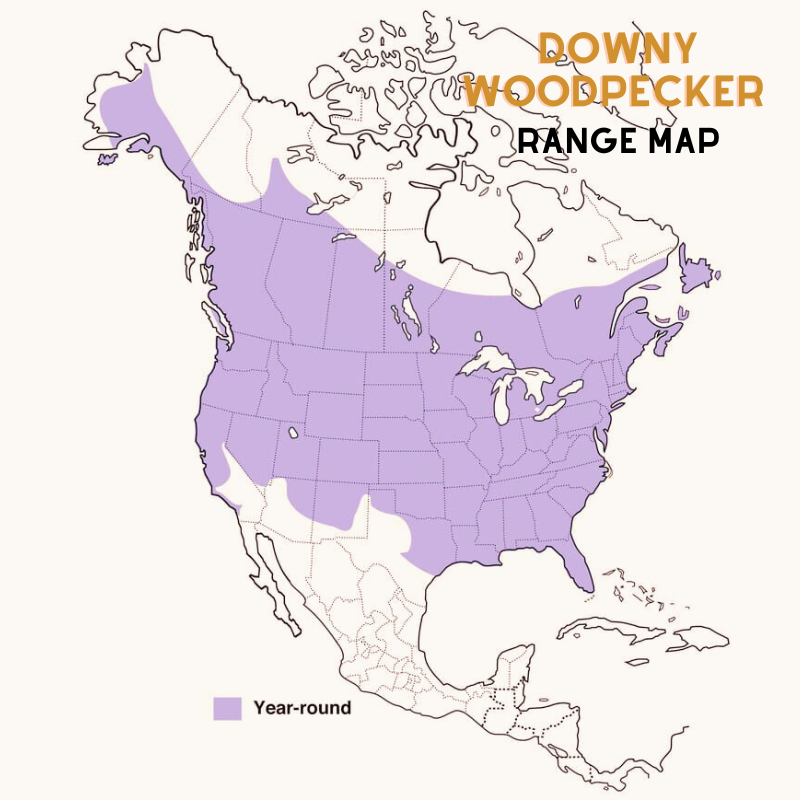
4. Hairy Woodpecker (Dryobates villosus)
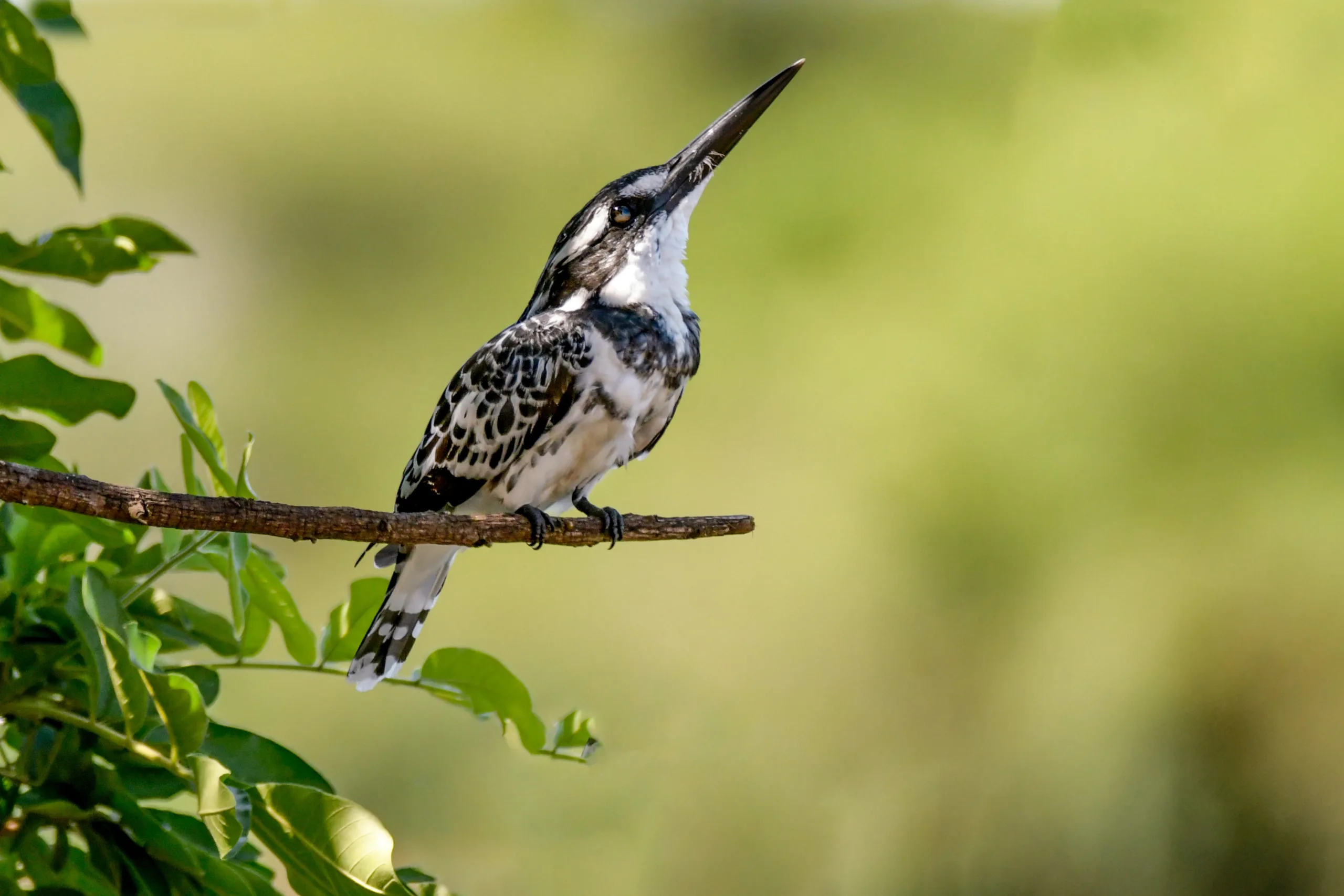
- Scientific Name: Dryobates villosus
- Lifespan:
- Average: 10 years
- Maximum Recorded: 15 years
- Size: 7.1 to 10.2 inches (18 to 26 cm)
- Weight: 1.4 to 3.4 ounces (40 to 95 g)
- Wingspan: 13 to 16.1 inches (33 to 41 cm)
- Status: Least Concern
Explanation: The Hairy Woodpecker, scientifically known as Dryobates villosus, exhibits a noteworthy average lifespan of 10 years, with some individuals reaching an impressive maximum of 15 years.
Hairy Woodpeckers have black wings, white underside, and a black tail. These striking black wings enhance their elegant appearance as they navigate through the trees. This woodpecker species boasts a size range of 7.1 to 10.2 inches, a weight between 1.4 to 3.4 ounces, and a wingspan spanning from 13 to 16.1 inches.
Despite potential variations in these measurements, the Hairy Woodpecker is currently classified as “Least Concern” in terms of its conservation status.
Breeding occurs from April to July.
The Hairy Woodpecker is a common sight in Georgia. It’s known for its black and white plumage and a white belly. Males have a small red patch on the back of their head.
Region: Georgia
Appearance: Black and white with a white belly. Males have a small red patch on the back of their head.
Habitat: Deciduous and mixed forests with plenty of trees for nesting and foraging.
It communicates by drumming to establish territory and attract mates. This behavior makes it stand out from other woodpecker species.
To spot the Hairy Woodpecker in Georgia, here’s what you can do:
- Provide nesting sites: Install nest boxes or leave dead trees standing.
- Offer food sources: Hang suet or provide bird feeders stocked with nuts, sunflower seeds and pine seeds.
- Create an inviting environment: Plant native trees like oak or pine to attract insects.
By doing this, you can create a habitat that meets the needs of the Hairy Woodpecker and attract them using bird bath and plant native trees like pine trees.
Also, if you’re lucky, you can spot the majestic Pileated Woodpecker. It has a pecking power that puts Thor’s hammer to shame!
Hairy Woodpecker Sound and Video
Hairy Woodpecker (Dryobates villosus) Range Map
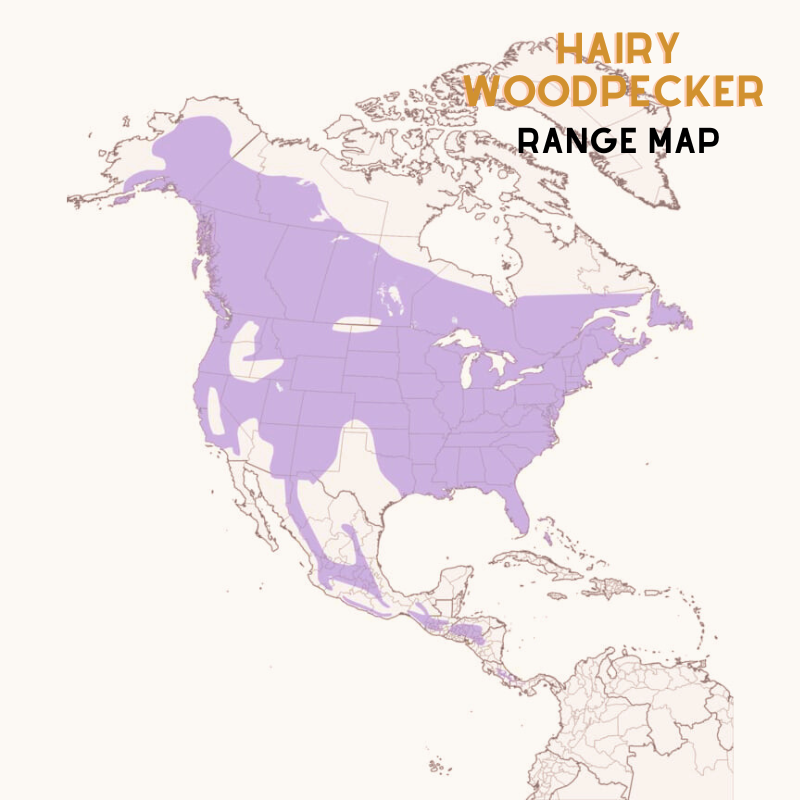
5. Pileated Woodpecker (Dryocopus pileatus)
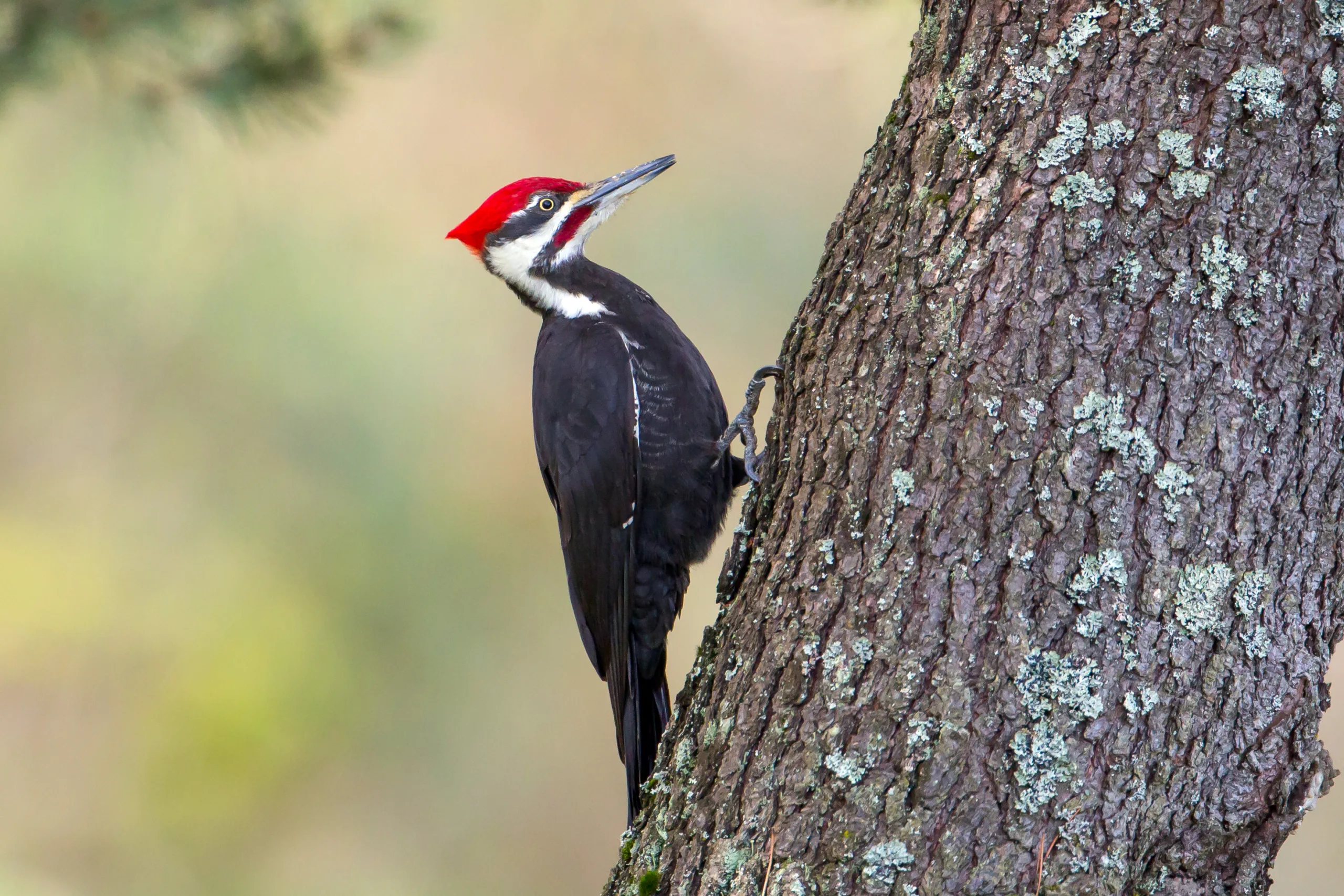
- Scientific Name: Dryocopus pileatus
- Lifespan:
- Average: 9 years
- Maximum Recorded: 12 years
- Size: 15.8 to 19.3 inches (40 to 49 cm)
- Weight: 8.8 to 12.3 ounces (250 to 350 g)
- Wingspan: 26 to 29.5 inches (66 to 75 cm)
- Status: Least Concern
Explanation: The Pileated Woodpecker also the largest woodpecker, identified by its scientific name Dryocopus pileatus, has an average lifespan of 9 years, with individuals occasionally reaching up to 12 years.
This striking woodpecker species is characterized by a considerable size range of 15.8 to 19.3 inches and a weight of 8.8 to 12.3 ounces.
Additionally, it features an impressive white stripes on their face wingspan ranging from 26 to 29.5 inches.
Despite its larger size, the Pileated Woodpecker can be identified by its white stripes neck and is currently labeled as “Least Concern” in terms of conservation status.
Breeding season typically runs from March to June.
The Pileated Woodpecker is an amazing bird found in Georgia. Here are some key facts about this species:
- – 19 inches long, it is one of the biggest woodpeckers in North America.
- – Easily recognizable with its red crest and black body.
- – Known for its strong drilling skills, making rectangular holes in trees.
- – Diet mainly consists of insects, ants, and beetle larvae.
- – Solitary birds that stay in the same territory year-round and mate for life.
- – Prefers mature forests with plenty of dead trees for nesting and foraging.
Moreover, it plays a crucial role in Georgia’s ecosystem, particularly within mature forests. These mature forests provide essential habitats that help keep insect populations under control, aiding in the forest’s renewal. As you explore Georgia’s mature forests, don’t forget to look out for a Pileated Woodpecker!
So, when you’re out exploring Georgia’s woods, don’t forget to look out for a Pileated Woodpecker!
Pro Tip: Try to locate the Pileated Woodpecker by listening for its loud calls and drumming sounds. It’ll help lead you to where they are actively foraging or setting up their territory.
Pileated Woodpecker Sound and Video
Pileated Woodpecker (Dryocopus pileatus) Range Map

6. Red-cockaded Woodpecker (Dryobates borealis)

- Scientific Name: Dryobates borealis
- Lifespan:
- Average: 12 years
- Maximum Recorded: 16 years
- Size: 7.9 to 9.1 inches (20 to 23 cm)
- Weight: 1.5 to 1.8 ounces (42 to 52 g)
- Wingspan: 13.4 to 16.1 inches (34 to 41 cm)
- Status: Near-threatened
Explanation: The Red-cockaded Woodpecker, scientifically termed Dryobates borealis, demonstrates an impressive average lifespan of 12 years, with some individuals living up to 16 years.
Red-cockaded Woodpeckers are characterized by small black markings on their sides. This species has a moderate size range of 7.9 to 9.1 inches, weighing between 1.5 to 1.8 ounces. Its wingspan spans from 13.4 to 16.1 inches.
Unfortunately, the Red-cockaded Woodpecker is currently classified as “Near-threatened,” emphasizing the need for conservation efforts to ensure its survival.
Breeding season usually occurs from March to July.
Discover the Red-cockaded Woodpecker – a unique species found in Georgia! It’s listed as an endangered species because of habitat loss and fragmentation.
They like mature pine forests with open understories to build their nests. Plus, they have a black cap with white cheeks and black markings on sides.
This bird has an important role in its ecosystem, too. It creates cavities for other animals. Conservation orgs are trying to protect and restore its habitat.
Did you know? This woodpecker has a cooperative breeding system. Several male birds help a breeding pair raise their young.
Go on a guided birding tour or visit protected areas to observe the Red-cockaded Woodpecker in its natural habitat. Enjoy the beauty of nature and help conserve this amazing Ggeorgia species! in the United States.
The red-cockaded woodpecker, an endangered species, resides in small groups in mature pine forests in South Georgia.
Red-cockaded Woodpecker Sound and Video
Red-cockaded Woodpecker (Dryobates borealis) Range Map
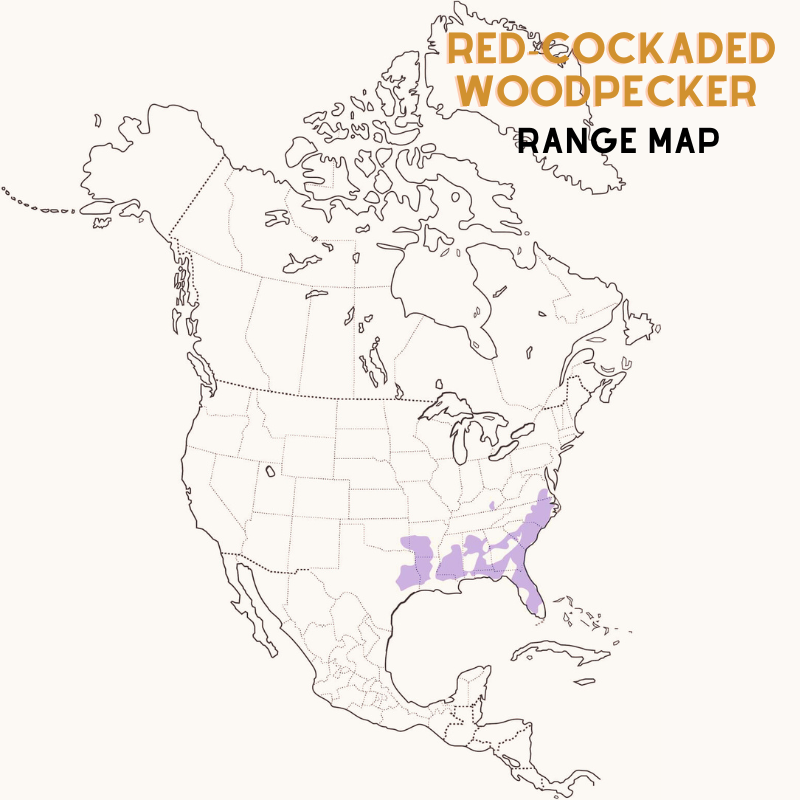
7. Yellow-bellied Sapsucker (Sphyrapicus varius)
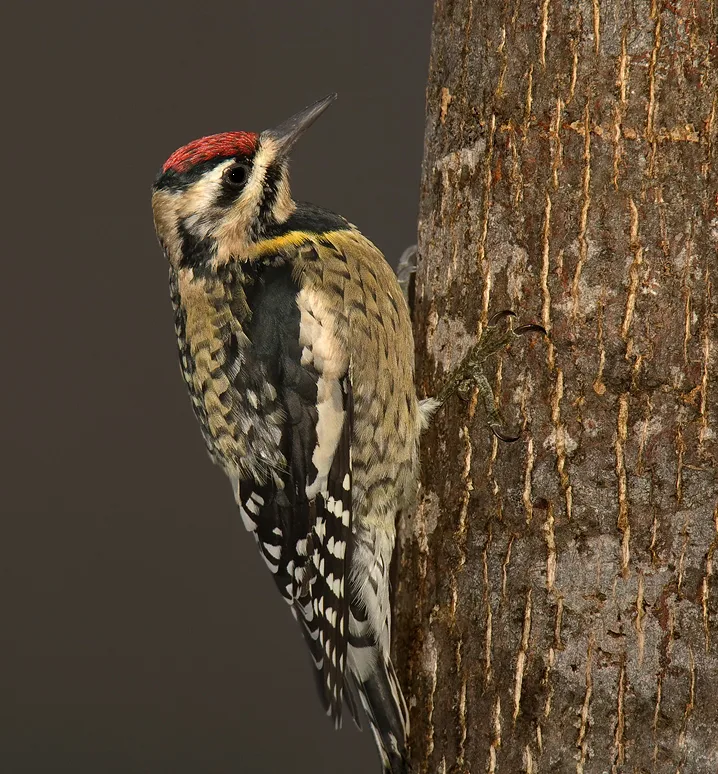
- Scientific Name: Sphyrapicus varius
- Lifespan:
- Average: 6 years
- Maximum Recorded: 8 years
- Size: 7.1 to 8.7 inches (18 to 22 cm)
- Weight: 1.5 to 1.9 ounces (43 to 55 g)
- Wingspan: 13.4 to 15.8 inches (34 to 40 cm)
- Status: Least Concern
Explanation: The Yellow-bellied Sapsucker, scientifically known as Sphyrapicus varius, has an average lifespan of 6 years, with some individuals living up to 8 years.
The Yellow-bellied Sapsucker has a white stripe on its wings and a white patch on its back.
This bird presents a size range of 7.1 to 8.7 inches, weighing between 1.5 to 1.9 ounces, and featuring a wingspan of 13.4 to 15.8 inches. With white spots on the tail and a red crescent on the head and yellow bellies, it is uniquely identified.
Currently, the Yellow-bellied Sapsucker holds a “Least Concern” status in terms of conservation, indicating a stable population.
The Yellow-bellied Sapsucker is a truly striking woodpecker species found in Georgia. It boasts unique features and behaviors like no other!
Check out the key features of this woodpecker:
- Size: About 8-9 inches long.
- Appearance: Black and white plumage with a red crown.
- Range: Breeds in northern US and Canada.
- Habitat: Deciduous forests with trees for sap wells.
- Diet: Birds love to munch on a variety of foods found right in your garden. Their favorite food include plant sap, small bugs, the seeds from sunflowers, and juicy fruits that you might put out in feeders. On occasion, they may even eat the eggs of other birds.
Breeding takes place from April to June.
The Yellow-bellied Sapsucker is easily recognizable with its special drumming pattern during mating season. Plus, it creates “sap wells” by drilling rows of small holes in tree bark.
Research shows that this woodpecker plays a crucial role by providing food sources to other bird and mammal species, like squirrels.
As per The Cornell Lab of Ornithology, it has an interesting migratory pattern that often connects with deciduous forests. Some individuals breed in Alaska and Canada during summer and migrate south to wintering grounds in the southeastern US, including Georgia, where deciduous forests provide a vital habitat. This migration highlights the importance of conserving these essential deciduous forests for sustaining migratory bird populations.
So, when you’re exploring Georgia’s deciduous forests, keep an eye out for the vibrant Yellow-bellied Sapsucker! This migratory species likes to peck rows of small holes in deciduous trees, drinking the sap that flows out and feasting on insects attracted to it. You may find it perched on tree trunks, indulging in its sweet sap feast.
Yellow-bellied Sapsucker Sound and Video
Yellow-bellied Sapsucker (Sphyrapicus varius) Range Map

8. Northern Flicker (Colaptes auratus)

- Scientific Name: Colaptes auratus
- Lifespan:
- Average: 3 years
- Maximum Recorded: 9 years
- Size: 11 to 12.2 inches (28 to 31 cm)
- Weight: 3.9 to 5.6 ounces (110 to 160 g)
- Wingspan: 16.5 to 20.1 inches (42 to 51 cm)
- Status: Least Concern
Explanation: The Northern Flicker, scientifically referred to as Colaptes auratus, exhibits an average lifespan of 3 years, with certain individuals living up to 9 years.
The yellow-shafted morph displays a peach-colored face, red nape, black mustache stripe, black patch on their chest, and yellow feathers on the tail and wings. These striking yellow feathers not only enhance its appearance but also play a role in its identification among bird enthusiasts. As it flits through the trees, the vibrant yellow feathers catch the light, making the yellow-shafted morph a truly captivating sight in its natural habitat.
These woodpeckers have a brown body with black bars across their back and dark spots and black bars on wings, accentuated by a distinctive BLACK mustache stripe. This woodpecker species, known for its notable BLACK mustache stripe, showcases a size range of 11 to 12.2 inches, a weight between 3.9 to 5.6 ounces, and an impressive wingspan spanning from 16.5 to 20.1 inches.
These are identified with black dots or you can say black spots and red crescent and prefer pine trees. Currently categorized as “Least Concern,” the Northern Flicker’s conservation status indicates a stable population in its habitat.
Breeding season varies slightly across its range but generally occurs from April to July.
The Northern Flicker is a woodpecker species found in Georgia. Its scientific name is Colaptes auratus. It lives in open woodlands, forests, and suburban areas with trees. It eats insects, ants, beetles, berries, and seeds.
It has distinctively spotted plumage. It usually feeds on the ground rather than on tree trunks, which is different from other woodpecker species.
If you want to attract Northern Flickers to your area, give them suitable habitat. Plant fruit-bearing trees and leave dead tree limbs intact.
Mulching your garden with organic material is also a great way to draw them closer since they rely on ants. They are commonly seen at backyard bird feeders, particularly in areas with trees nearby.
Northern Flicker Sound and Video
Northern Flicker (Colaptes auratus) Range Map

Frequently Asked Questions
Q: How many types of woodpeckers are found in Georgia?
A: There are nine types of woodpeckers that can be found in Georgia: the Downy Woodpecker, Hairy Woodpecker, Red-bellied Woodpecker, Red-headed Woodpecker, Northern Flicker, Pileated Woodpecker, Yellow-bellied Sapsucker, Red-cockaded Woodpecker, and the Ivory-billed Woodpecker.
Q: What is the size range of woodpeckers in Georgia?
A: Woodpeckers in Georgia vary in size. The smallest woodpeckers, such as the Downy Woodpecker, measure around 6 to 7 inches in length, while the largest, like the Pileated Woodpecker, can reach up to 17 inches in length.
Q: When is the best time to spot woodpeckers in Georgia?
A: Woodpeckers are active year-round in Georgia, but the best time to spot them is during spring and early summer. During this time, they are more vocal and actively engaged in nesting and breeding activities.
Q: Where can I find woodpeckers in Georgia?
A: Woodpeckers can be found in various habitats in Georgia, including forests, woodlands, parks, and even suburban areas with enough trees. Look for dead or decaying trees, as woodpeckers often excavate holes in search of insects or establish their nests in such trees.
Q: Are woodpeckers in Georgia harmful to trees?
A: While woodpeckers do create holes in trees while foraging or nesting, they are not typically harmful to the overall health of the tree. In fact, their foraging activities can benefit the ecosystem by controlling insect populations. However, excessive pecking on buildings or man-made structures can cause damage and may require preventive measures.
Q: What are some unique characteristics of woodpeckers in Georgia?
A: Woodpeckers in Georgia have several unique characteristics. They have specialized adaptations such as strong beaks and reinforced skulls to withstand the forces of pecking. They also have a unique drumming behavior where they peck on trees to communicate and establish territories.
Q: How Georgia woodpeckers breeds.
A: Woodpeckers in Georgia always find a new spot for the breeding season.
Q: How Do Woodpeckers in Georgia Interact with Common Birds?
A: Woodpeckers in Georgia, such as the Red-headed and Pileated, often share habitats with common birds like chickadees and bluebirds. These woodpeckers are essential in creating nesting cavities used by many common birds for shelter. The interaction between woodpeckers and common birds supports pest control as both feed on insects, benefiting the ecosystem. Observing woodpeckers alongside common birds offers a glimpse into their coexistence in Georgia’s diverse landscapes.
How can damage from woodpeckers in Georgia be prevented?
Damage from woodpeckers in Georgia often involves creating holes in trees, siding, and wooden structures while searching for food or nesting. To prevent this, use deterrents like reflective objects, netting, or decoy predators, and maintain wood surfaces. If issues persist, seek advice from a wildlife expert.
How do woodpeckers in Georgia interact with ash trees?
Woodpeckers in Georgia may peck at ash trees while searching for insects or creating nesting sites. While this can help control insect populations, excessive pecking might stress the trees. To manage woodpecker activity on ash trees, consider using deterrents or consulting a wildlife expert if necessary.
How do woodpeckers in Georgia interact with common trees?
Woodpeckers in Georgia often interact with common trees like oaks and maples by pecking at the bark to find insects or create nesting sites. This behavior can help reduce pest populations but may also cause damage to the trees. To protect these common trees, consider using deterrents or seeking guidance from a wildlife expert if needed.
How do woodpeckers in Georgia interact with the platan tree?
Woodpeckers in Georgia may peck at platan trees to forage for insects or to establish nesting sites. This interaction can help manage insect populations but might also lead to damage on the tree bark. To mitigate potential issues with platan trees, consider implementing deterrents or consulting a wildlife expert for effective management strategies.
Interesting Facts
Keystone Carvers of Georgia's Wilderness
In Georgia, endangered woodpeckers like the Red-cockaded Woodpecker, an endangered bird, are crucial to the health of forest ecosystems. By creating nesting cavities in mature pine trees, often referred to as cavity trees, these endangered woodpeckers support biodiversity, providing homes for various other species and playing a significant role in the conservation of the region’s natural habitats.
Georgia's Feathered Architects
Woodpecker Georgia are nature’s architects, expertly crafting nesting cavities in trees. These cavities provide essential homes for other species like bluebirds and chickadees, showcasing the vital role woodpeckers play in supporting biodiversity.
Red-cockaded Conservation Champions
The Red-cockaded Woodpecker, a native species of woodpecker Georgia, is a conservation priority due to its near-threatened status. Efforts to preserve mature pine forests are crucial for maintaining their habitat and ensuring their survival.
The Drumming Communicators
Woodpecker Georgia use drumming not just for foraging but as a form of communication. This rhythmic pecking helps them establish territory and attract mates, making them unique among bird species.
Downy Woodpeckers: Tiny Ninjas
Among the woodpecker Georgia, the Downy Woodpecker is known for its stealthy presence. Despite their small size, they are adept at navigating trees in search of insects, often tapping away quietly like ninjas.
Pileated Powerhouses
The Pileated Woodpecker is the largest of the woodpecker Georgia, known for its powerful drilling capabilities. It creates large, rectangular holes in trees to access insects, showcasing its strength and persistence.
Ecosystem Engineers
Woodpecker Georgia help control insect populations, acting as natural pest regulators. Their foraging habits contribute to the health of forests, underscoring their role as crucial ecosystem engineers.
Seasonal Migrants
Some woodpecker Georgia, like the Yellow-bellied Sapsucker, migrate seasonally. These birds travel from northern breeding grounds to the southeastern U.S., including Georgia, highlighting the importance of conserving forest habitats along their migratory routes.
Colorful Characters
The Northern Flicker, a type of woodpecker Georgia, stands out with its spotted plumage and bright yellow feathers. Unlike other woodpeckers, it often feeds on the ground, adding a unique twist to its ecological niche.
Acoustic Navigators
Woodpecker Georgia possess an extraordinary sense of hearing that aids them in locating insects hidden beneath tree bark. This keen auditory ability allows them to detect subtle movements and vibrations, making them adept hunters and crucial contributors to maintaining the forest ecosystem’s health.
